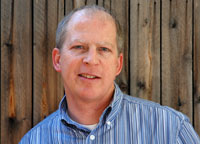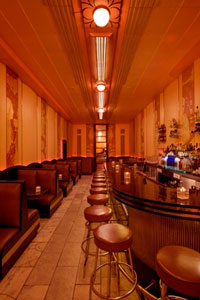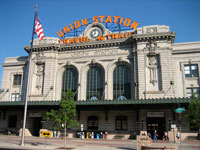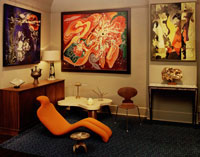 David Hill / Photo courtesy David Hill |
 Cruise Room / Courtesy Oxford Hotel  Denver Union Station / Courtesy Wikipedia  Kirkland Museum interior / Courtesy Kirkland Museum of Fine & Decorative Art |
David Hill, a journalist based in Denver, is a regular contributor to Architectural Record and writes frequently about architecture, design, and urban planning.
Best Historic Architecture
Denver Union Station: The elegant 1914 central portion, at 17th and Wynkoop Streets in Lower Downtown, was designed in the Beaux-Arts style by the Denver firm Gove & Walsh. (The two wings are older.) The historic train station is currently closed as it undergoes a $48 million restoration and conversion into a hotel. But it will continue to serve train passengers, and if you walk around to the back of the station, you’ll see how the former rail yard is being transformed into a 20-acre mixed-use transit hub.
Best Public Space
Civic Center Park: Conceived by Denver mayor Robert Speer in the early part of the 20th century, this civic space is consider a shining example of City Beautiful landscape design. The park was designated a National Historic Landmark in October 2012. It is surrounded by some of Denver’s most notable buildings, including the gold-domed State Capitol (the dome is currently being restored), the City and County Building, Gio Ponti’s 1971 Denver Art Museum North Building, and the Denver Public Library (Burnham Hoyt, 1956; addition, Michael Graves, 1995). In the park itself is the newly restored McNichols Civic Center Building, built in 1909 as a Carnegie Library.
Best New Architecture
The Clyfford Still Museum: Brad Cloepfil’s textured-concrete museum sits in the shadow of Daniel Libeskind’s flamboyant 2006 addition to the Denver Art Museum. But where Libeskind’s building seems to reach for the sky, Cloepfil’s two-story museum, which opened in 2011, is intimate and earthbound. Inside are masterworks by the famously irascible painter, whose will stipulated that his entire estate be given to an American city willing to build a museum devoted to his work. Denver stepped up to the plate.
Best Museum
The Kirkland Museum of Fine & Decorative Art: Located in Capitol Hill, in the Arts & Crafts-style studio of Colorado artist Vance Kirkland (1904-1981), this museum is jam-packed with thousands of pieces of decorative art from the 20th century, along with works by Kirkland and other Colorado artists. A sampling: tableware by Russel Wright and Eva Zeisel, furniture by Eero Saarinen and Gio Ponti, and paintings by Herbert Bayer and Charles Bunnell.
Best Outdoor Sculpture
Articulated Wall (1986) by Herbert Bayer: The multifaceted Bauhaus designer spent many years in Aspen, where he designed the 40-acre campus of the Aspen Institute for Humanistic Studies. Articulated Wall—completed the year after Bayer’s death—is an 85-foot-tall sculpture made of 32 pieces of offset, prefabricated concrete bars painted canary yellow. Located in the Denver Design District, south of downtown, Articulated Wall is owned by the Denver Art Museum, which has an extensive collection of works by Bayer. (Herbert Bayer 1900 to 1928: The Bauhaus and Pre-Bauhaus Years is on display at the museum through July 14, 2013.)
Best Bars
The Cruise Room: This Art Deco gem in the historic Oxford Hotel has barely changed since it opened in 1933, on the day after Prohibition was repealed. It’s allegedly modeled after a lounge on the Queen Mary cruise ship and is the perfect place to enjoy a martini.
My Brother’s Bar: Don’t look for a sign out front—there isn’t one. This classic burgers-and-beer joint at the corner of 15th and Platte streets has been a Denver institution since 1970, but there’s been a saloon on the same spot since 1873. Be sure to check out the framed letter Neal Cassady (the inspiration for Jack Kerouac’s On the Road) wrote from the Colorado State Reformatory in 1944 asking a friend to pay off his tab at the bar, then called Paul’s Place.
